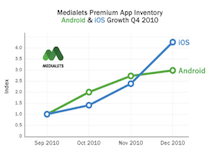 Comparing the iOS and Android platforms is often tricky because the perspective is usually one-sided. But mobile ad platforms tend to have a pretty well-rounded look at the state of things because they’re agnostic in the religious war that is iOS versus Android. And of those, Medialets has one of the best views since their data comes from only big-time app makers which tend to be on both platforms. Apps like Pandora, New York Times, Fandango, CNN, The Weather Channel, and a wide range of others. In other words, the “premium apps”. So what are they seeing?
Comparing the iOS and Android platforms is often tricky because the perspective is usually one-sided. But mobile ad platforms tend to have a pretty well-rounded look at the state of things because they’re agnostic in the religious war that is iOS versus Android. And of those, Medialets has one of the best views since their data comes from only big-time app makers which tend to be on both platforms. Apps like Pandora, New York Times, Fandango, CNN, The Weather Channel, and a wide range of others. In other words, the “premium apps”. So what are they seeing?
First and foremost, to state the obvious, mobile is exploding across the board. Medialets says their premium inventory rose almost 300 percent in the fourth quarter of 2010. Pretty much every report you will have read in the past few years will say the same thing.
But while Medialets acknowledges that Android has surpassed iOS in U.S. market share, iOS is still dominating among the premium brands that they serve. These premium apps are simply moving faster still on iOS and so Medialets is serving up more inventory for them there. Android had surged ahead for a few months in terms of growth, but iOS dominated in the holidays.

In terms of Android fragmentation, Medialets also acknowledges that it is very real, but it appears to be less of an issue for these premium apps. From a device perspective, the top 3 Android devices running these apps make up some 35 percent of the share of premium inventory that Medialets serves up on Android. The top 10 devices make up 63 percent.
What are these top Android devices? Medialets’ data points to the Droid, the EVO4G, the Droid X, the Incredible, and the Droid 2. Given that list, it should be no surprise that Verzon dominates in terms of Android carrier spread Medialets see. The nation’s largest carrier has some 48.5 percent of the market. Sprint comes in second at 24 percent. Then T-Mobile at 17 percent. And AT&T? All the way down at just 3 percent.
The most interesting thing to see there, of course, is what happens now that the iPhone is available on both AT&T and Verizon?AT&T clearly has started pushing Android more than the previously were. But does the data suggest that when both the iPhone and Android phones are available on a carrier, the majority go with iPhone? It certainly seems that way among those that Medialets sees, at least.

In terms of Android manufacturers, HTC leads the way at 38 percent. Motorola is second at 34 percent. Samsung has just under 20 percent. Then there are a group of others that are much smaller.
In the iPad and iPhone arena, both saw huge surges in the holiday times, as Apple’s own sales data has indicated. And yes, the iPhone sill has a clear lead over its bigger brother in terms of inventory that Medialets is serving.
Breaking down iOS, 68 percent of users are on iOS 4.x. And basically all of the remaining 32 percent are on iOS 3.x. These numbers aren’t as striking as the 90 percent iOS 4.x numbers talked about recently, but they still point to fragmentation not being nearly the issue that it is on Android.
In terms of who is buying up Medialets premium ad spots, it’s largely automotive companies right now at just about 35 percent. Behind that is restaurants and then entertainment.

